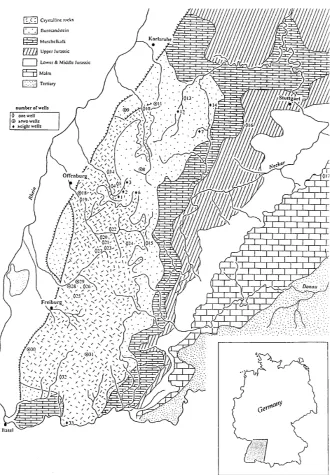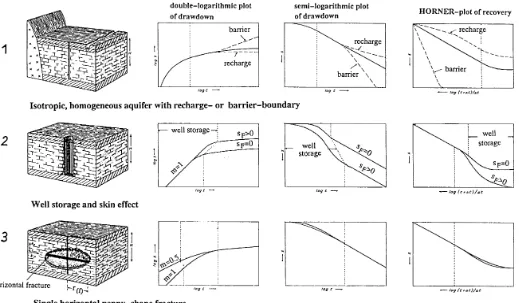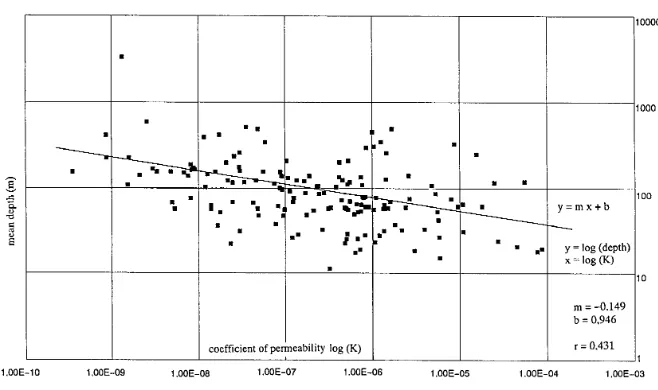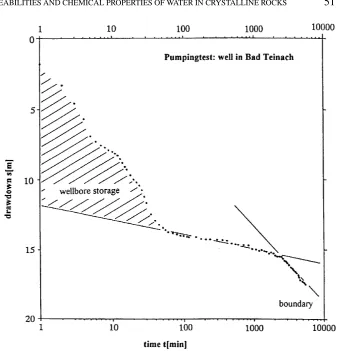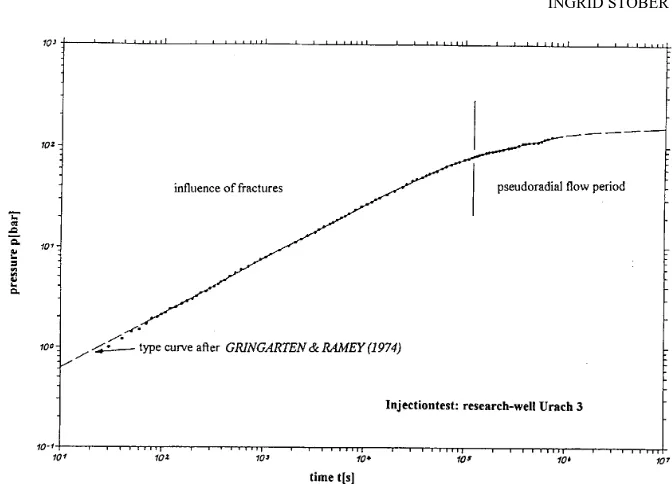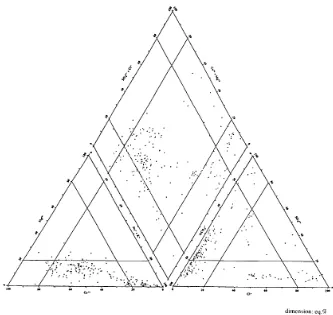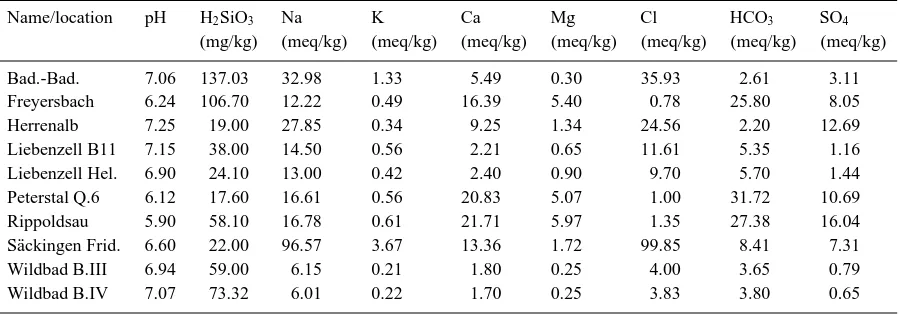Aquatic Geochemistry 3: 43–60, 1997. 43 c
1997 Kluwer Academic Publishers. Printed in the Netherlands.
Permeabilities and Chemical Properties of Water in
Crystalline Rocks of the Black Forest, Germany
INGRID STOBER
Geologisches Landesamt Baden-W¨urttemberg, Albertstr. 5, D-79104 Freiburg i.Br., Germany
(Received: 12 October 1996; in final form: 18 March 1997)
Abstract. Investigations were carried out to determine the hydraulic and hydrochemical properties of crystalline rocks in the Black Forest of Germany and neighbouring regions. Rock permeabilities (K) were determined to a depth of 3500 m. These parameters range fromK= 3.510
10
m s 1toK= 8.710
5
m s 1; and can increase up to an order of magnitude which is typical for porous aquifers. It is shown that on an average, granites are more pervious than gneisses and only the permeabilities of gneisses decrease with depth.
The geochemistry of natural waters in crystalline rocks is not constant, but varies with depth and location. The concentration increases with depth and the water-type changes from a Ca—Na—HCO3
-type (or Na—Ca—HCO3—) at shallow depths to a Na—Cl-type at greater depths. Thermal springs
are found only in granitic rocks with on average higher permeabilities than in gneisses. Thermal waters are welling up in valleys at the bottom of steep mountains. The chemical composition of thermal spring water is identical to that of water found at greater depths. Using geothermometers it is found, that the depth of the deposits of thermal spring water in the crystalline basement rocks of the Black Forest is some 1000 m below the surface. The topographic relief in the mountains induces a deep circulation of infiltrating rain-water with an upwelling as thermal springs in the valleys.
Key words: crystalline rocks, hydraulic properties, hydrochemical properties, Black Forest.
1. Introduction
Super deep wells, such as the Kola well – situated in the former U.S.S.R – with a depth of 12 500 m show, that there are open, waterfilled fissures in crystalline rocks. The object of this investigation was to explore the rock permeabilities and the chemical properties of water in the crystalline rocks of the Black Forest in Germany and neighbouring regions (Figure 1).
The crystalline basement is being considered as a possible host rock for a waste repository, because of its assumed low hydraulic conductivity. However, hydrogeologic evidence shows, that there are several thermal and mineral water springs in crystalline rocks, possibly contradicting assumptions of generalized impermeable conditions.
44 INGRID STOBER
Figure 1. Geological map of the Black Forest and neighbouring regions (South Western
Germany).
PERMEABILITIES AND CHEMICAL PROPERTIES OF WATER IN CRYSTALLINE ROCKS 45
the Upper Rhine Graben, the updoming of the Black Forest and the formation of the Folded Jura.
Results of rock conductivities and water chemistry in the study area are presented below.
2. Hydraulic Methods
From pumping or injection tests, recharge tests, slug tests, water pressure tests, tracer tests, fluid logging tests, earth tide methods among others it is possible to determine in situ transmissivities and/or coefficients of permeability of rock strata.
Pumping or injection tests produce the best information about the aquifer, its
structure and properties (Figure 2a,b). Recharge and slug tests, only provide data on the nearest domain around the well or borehole, but this part of the aquifer is very often disarranged by drilling, well design, etc. To apply fluid-logging tests, much additional information and measurement is necessary; additionally, the interpreta-tion is based on restricted assumpinterpreta-tions concerning the aquifer. Because earth-tide forces are acting on extended areas of the whole earth, results from earth-tide
meth-ods are parameters integrated over very large areas and therefore difficult to
inter-pret. Permeabilities from water-pressure tests are based on empirical assumptions, and are not therefore considered in these investigations. Successful tracer-tests in crystalline rocks are very difficult to conduct, because velocities are very small, and flow-paths and flow-directions are mostly unknown (Stober, 1986; Reifenstahl and Stober, 1990; Kruseman and de Ridder, 1991).
3. Hydraulic Data/Data Base
Mainly pumping tests exist. The oldest tests date from the 1950s, but are not a quality criterion, because in former times people concentrated on getting steady state (constant drawdown) during pumping-tests, and therefore these tests were carried out very slowly and carefully.
Nevertheless the quality of the data, derived from the examined hydraulic tests, differed greatly. It can be explained partly by the conception of that time. Frequently a pumping test was only a trial, to see if water was present and test its quality. Therefore several tests were carried out in a very short time, the withdrawal rate oscillated very strongly or the registration of the data was scanty. Also, several tests were carried out in thermal water, where special requirements to analyse a test are necessary (Stober, 1986). In inclined wells measurements of the water level during pumping tests had to be corrected.
determi-46
INGRID
ST
OBER
PER
48 INGRID STOBER
Figure 3. Distribution of the coefficient of permeability K in crystalline rocks.
Figure 4. Distribution of the coefficient of permeability K in granites and gneisses.
nation of transmissivities, rarely of storage coefficients and parameters describing the geometry of fissures.
PERMEABILITIES AND CHEMICAL PROPERTIES OF WATER IN CRYSTALLINE ROCKS 49
4. Calculated Permeabilities (Transmissivities)
The permeabilities determined in gneiss and granite rocks vary fromK = 3.5 10 10m s 1 to
K = 8.710
5 m s 1, the accompanying transmissivities from
T = 1.0 10
7 m2/s to
T = 4.7 10
3 m2/s. The range of both parameters is wide. It is remarkable that the permeability – respectively the transmissivity – of crystalline rocks can increase up to an order of magnitude, which is typical for porous aquifers.
The permeabilities of the crystalline basement in the Black Forest are neither lower nor higher than in other crystalline rocks (Table I).
The calculated permeabilities/transmissivities suggest a logarithmic normal dis-tributed evenly (Figure 3), just as the permeabilities in pure granite and in pure gneiss rocks (Figure 4). The analogous average values are:
Table I. Mean permeability in crystalline rocks of the Black Forest
Rock Mean permeability K (m/s)
Total crystalline 2.14 10 7
Granite 9.55 10 7
Gneiss 5.01 10 8
The averages are the arithmetic means of the logarithms of the individual values. The highest values of the calculated permeabilities are found in boreholes in granite rocks. Permeabilities in pure gneiss rocks turned out to be smaller. Of course there is a smooth transition zone. Gneiss rocks with granitic intrusions take an intermediate position.
The great difference between permeabilities in granite and gneiss rocks is not confined to these rock types, there are also boreholes in granite rocks, which show a very low permeability. The minerals in granites are very uniformly and randomly distributed. If any tectonic stress is present, the behaviour of granite rocks is much more rigid than that of gneisses. Gneisses are more elastic because of their texture, which is characterized by mica plates in single layers. Therefore granites break more easily than gneisses and are frequently more fractured and consequently they are more permeable.
The permeability in granite rocks seems to be independent of depth, whereas in gneiss rocks a distinct decrease of permeability with increasing depth exists (Figure 5).
50 INGRID STOBER
Figure 5. Coefficient of permeability K in dependence of depth.
Figure 6. Example for intensively fractured crystalline rock, acting like a homogeneous,
isotropic aquifer.
5. Flow Behaviour/Flow Path
PERMEABILITIES AND CHEMICAL PROPERTIES OF WATER IN CRYSTALLINE ROCKS 51
Figure 7. Example for the influence of a fault-line, simulating hydraulic boundaries.
In intensively fractured crystalline rocks the hydraulic reaction is the same as in a homogeneous, isotropic aquifer (Figure 6). This flow behaviour is typical for granite rocks (cap. 4).
Near faults/fault-lines, dykes or mineral veins the pumping test data revealed the influence of hydraulic boundaries (Figure 7).
The hydraulic behaviour in wells, getting water from only a few fractures, corresponds to the theoretical model of single vertical, horizontal or inclined
fractures in homogeneous, isotropic aquifers (Figure 8).
Descriptions of drilling foremen and geophysical logs in boreholes together with geological profiles show, that water-bearing complexes are attached to
52 INGRID STOBER
Figure 8. Example for the model of a horizontal fracture in a homogeneous isotropic aquifer.
Contact areas between granites, granite dykes and granite porphyries on the one hand and gneisses on the other; intensively fissured granite dykes within paragneisses.
Old circulation-paths, like: hydrothermal altered or strained areas, mineral veins, or open fractures filled with minerals.
The magnitude of the permeability in crystalline rocks is supposed to depend on those characteristics. Biotit-rich gneisses on the other hand have extremely low permeability (cap. 4).
6. Geochemistry of Natural Waters in Crystalline Rocks
About 200 checked chemical analyses of water within crystalline rocks of the Black Forest were briefly interpreted by Stober (1993). The complete analyses are published in Stober (1993). The groundwater composition is used to trace the origin of thermal springs in the Black Forest. The geochemistry of groundwater in crystalline rocks is not uniform but broadly variable as shown on Figure 9a. Some examples for groundwater analyses are given in Table III.
It turned out, that groundwater-quality is changing with depth:
PERMEABILITIES AND CHEMICAL PROPERTIES OF WATER IN CRYSTALLINE ROCKS 53
Figure 9a. Data of chemical analyses in crystalline basement rocks.
54
INGRID
ST
OBER
Table II. Selected chemical analyses of characteristic waters in crystalline basement rocks
Name/location pH H2SiO3 Na K Ca Mg Cl HCO3 SO4
(mg/kg) (meq/kg) (meq/kg) (meq/kg) (meq/kg) (meq/kg) (meq/kg) (meq/kg)
Bad.-Bad. 7.06 137.03 32.98 1.33 5.49 0.30 35.93 2.61 3.11
Freyersbach 6.24 106.70 12.22 0.49 16.39 5.40 0.78 25.80 8.05
Herrenalb 7.25 19.00 27.85 0.34 9.25 1.34 24.56 2.20 12.69
Liebenzell B11 7.15 38.00 14.50 0.56 2.21 0.65 11.61 5.35 1.16
Liebenzell Hel. 6.90 24.10 13.00 0.42 2.40 0.90 9.70 5.70 1.44
Peterstal Q.6 6.12 17.60 16.61 0.56 20.83 5.07 1.00 31.72 10.69
Rippoldsau 5.90 58.10 16.78 0.61 21.71 5.97 1.35 27.38 16.04
S¨ackingen Frid. 6.60 22.00 96.57 3.67 13.36 1.72 99.85 8.41 7.31
Wildbad B.III 6.94 59.00 6.15 0.21 1.80 0.25 4.00 3.65 0.79
PERMEABILITIES AND CHEMICAL PROPERTIES OF WATER IN CRYSTALLINE ROCKS 55
Figure 10a. Na-portion in waters of crystalline rocks depend on depth.
Figure 10b. Cl-portion in waters of crystalline rocks dependent on depth.
The character of groundwater quality changes from a Ca—Na—HCO3-type (or Na—Ca—HCO3—) near surface over a Na—Ca—SO4—HCO3-type at medium depth to a Na—Cl-type at great depth (Figure 10a,b). Figure 10a illustrates for example that at depths greater then 300 m the concentration of the Na-ions will be more than 45 equ.%. Table IV shows the main contents of deep crystalline groundwaters in the Black Forest.
56 INGRID STOBER
Table III. Main contents of deep crystalline ground-waters
Cations (equ.%) Anions (equ.%)
Na+
90 Cl 80
Ca2+
<7 HCO
3 <10 Mg2+
<1 SO
2
4 <10
Figure 11. Sch¨oller diagram of mineral waters of the crystalline basement of the Black Forest.
Some typical analyses are shown on the Schoeller-diagram Figure 11. The total con-centration of the dissolved substances increases and the concon-centrations of calcium and magnesium can exceed the solubility of the equivalent carbonates.
PERMEABILITIES AND CHEMICAL PROPERTIES OF WATER IN CRYSTALLINE ROCKS 57
Figure 12. Sch¨oller diagram of thermal waters of the crystalline basement of the Black Forest.
Figure 13. Schematic illustration of types dependent on depth,
58 INGRID STOBER
Table IV. Composition of groundwater with high CO2-concentration
fluids, breakdown of fluid inclusions, water-rock interactions, radiolytic decompo-sition of water and other theories. The complexity of potential theories concerning the genesis of saline groundwater is wide. However saline waters in deep crys-talline basement rocks appear to be the rule worldwide rather than the exception. A global control-mechanism probably water-rock interactions is evident (Stober 1993). Edmunds and Savage (1991) derived the salinity in the Carnmenellis granite (SW-England) by water-rock interaction and extra-granitic fluids from surround-ing sedimentary rocks in earlier, high temperature hydrothermal phases. Frape and Fritz (1987) emphasize that most of the salinity of deep groundwaters from the Canadian Shield appears to be derived from intense water-rock interaction with local host rocks, rather than being derived from external sources.
With the aid of geothermometers (Nordstrom et al., 1985; Grimaud et al., 1990), and using chemical analyses of thermal waters, it was possible to determine the temperatures of the deposits, the waters were coming from. In this case the SiO2-geothermometer was used to measure the relatively low temperatures. The geotemperatures were used to calculate the potential depths of the deposits the waters were coming from. This calculation is finally based on data of concentrations of uranium and thorium in crystalline basement rocks and corresponding heat generation units. Using these data you can calculate the undisturbed geothermal gradients. The depth of these deposits in the crystalline basement of the Black Forest is some 1000 m below surface (Table V). Some typical hydrochemical analyses of thermal springs are shown on the Schoeller diagram Figure 12.
val-PERMEABILITIES AND CHEMICAL PROPERTIES OF WATER IN CRYSTALLINE ROCKS 59 Table V. Computed geotemperatures and derived potential depths of
deposits
Location/well Temp. of Geotemp. Pot. depth pumped water from SiO2 of deposit
(
C) (
C) (m b. s.)
Baden-Baden Pfl. 1 61.2 101 3400
Baden-Baden Pfl. 2 53.6 101 3400
Bad Wildbad B.IV 40.1 74 2400
Bad Wildbad B.V 35.8 73 2400
Bad Liebenzell XX2 21.9 64 2000
Bad Liebenzell XX3 23.7 63 2000
Bad Teinach Otto-Th. 26.3 71 2300
leys. The chemical composition of thermal water reflects therefore the water type at great depth.
Acknowledgements
The author is grateful to J. W. Morse and two unknown reviewers for their valuable comments and discussions. This work was partly supported by a grant from the Deutsche Forschungsgemeinschaft (DFG).
References
Batchelor A. S. (1986) Reservoir Behaviour in a Stimulated Hot Dry Rock System. – 11th Workshop
on Geothermal Reservoir Engineering. Stanford University, California (unpublished), 7 pp.
Behr H. (1989) Die geologische Aktivit¨at von Krustenfluiden.- Nieders¨achsische Akademie der
Geowissenschaften, Ver¨offentlichungen, H.1, S. 7-41, Hannover.
Carlsson L. and Olsson T. (1985) Hydrogeological and Hydrochemical Investigations in Boreholes –
Final report. Nagra Technical Report 85-57, 104 S., Baden/Schweiz.
Edmunds W. M., Kay L. F. and Cartney R. A. (1985) Origin of saline groundwaters in the carnmenellis granite: Natural processes and reaction during hot dry rock reservoir circulation. Chem. Geol. 49, 287–301.
Edmunds W. M. and Savage D. (1991) Geochemical Characteristics of groundwater in granites and related crystalline rocks, In Applied Groundwater Hydrology, A British Perspective (eds. R. A. Downing. and W. B. Wilkinson). Clarendon Press, Oxford, pp. 266–282.
Frape S. K. and Fritz P. (1987) Geochemical trends for groundwaters from the Canadian Shield, in:
Saline water and gases in crystalline rocks.– Geol. Assoc. Canada Spec. Paper 33 (eds. P. Fritz,
and S. K. Frape), pp. 19–38.
Gale J., MacLeod R., Welhan J., Cole C. and Vail L. (1987) Hydrogeological Characterization of the
Stripa Site. Nagra Technical Report 87-34, 153 S., Baden/Schweiz.
Grimaud D., Beaucaire C. and Michard G. (1990) Modelling of the evolution of ground waters in a granite system at low temperatures: the Stripa groundwaters, Sweden. Applied Geochemistry 5, 515–525.
60 INGRID STOBER
Jung R. (1990) Hydraulic fracturing and hydraulic testing in the granitic section of borehole GPK1, Soultz-sous-Forˆets. – Bundesanstalt f¨ur Geowissenschaften und Rohstoffe, Archiv-Nr.106616, 31 S., Anhang, Hannover.
Karrenberg H. (1981) Hydrogeologie der nichtverkarstungsf¨ahigen Festgesteine. Springer-Verlag, 284 S., Wien.
Kelley V. A., Lavanchy J. M. and L¨ow S. (1991) Transmissivities and Heads Derived from Detailed
Analysis of Siblingen 1989 Fluid Logging Data. Nagra Technical Report 90-09, 184 S.,
Wettin-gen/Schweiz.
Kodai K. (1984) Graphic representation of rock permeabilities, Bull. Geol. Surv. Japan 35(9), 419– 434.
Kov´acs G. (1981) Seepage Hydraulics. Elsevier, Amsterdam, Oxford, New York.
Kruseman G. P. and De Ridder N. A. (1991) Analysis and Evaluation of Pumping Test Data. ILRI publication 47, 2nd edn (completely revised), Wageningen, The Netherlands, 377 pp.
K¨upfer Th., Hufschmied P. and Pasquier F. (1989) Hydraulische Tests in Tiefbohrungen der Nagra. Nagra informiert, Nr.3 + 4, 11.Jg., S.7-23, Bern.
Leech R. E. J., Kennedy K. G. and Gevaert D. (1984) Sondierbohrung B¨ottstein Hydrogeological
Testing of Crystalline Rocks. Nagra Technischer Bericht 85-09, 155 S., Baden/Schweiz.
Nagra (1985) Sondierbohrung B¨ottstein, Untersuchungsbericht. Nagra Technischer Bericht 85-01, 190 S., Anlagen, Baden/Schweiz.
Nagra (1989) Sondierbohrung Weiach, Untersuchungsbericht. Nagra Technischer Bericht 88-08, 183 S., Anlagen, Baden/Schweiz.
Nagra (1991a) Sondierbohrung Kaisten, Untersuchungsbericht. Nagra Technischer Bericht 88-12, 157 S., Anlagen, Baden/Schweiz.
Nagra (1991b) Sondierbohrung Leuggern, Untersuchungsbericht. Nagra Technischer Bericht 88-10, 168 S., Anlagen, Baden/Schweiz.
Nagra (1992) Sondierbohrung Schafisheim, Untersuchungsbericht. Nagra Technischer Bericht 88-11, 193 S., Anlagen, Baden/Schweiz.
Nordstrom D. K., Andrews J. N., Carlsson L., Fontes J-C., Frits P., Moser H. and Olsson T. (1985)
Hydrogeological and Hydrogeochemical Investigations in Boreholes – Final Report of the Phase I Geochemical Investigations of the Stripa Groundwaters. Technical Report STRIPA Project,
Stockholm, pp. 85–06.
Parker R. (1988) The Camborne School of Mines: Hot Dry Rock Geothermal Energy Project. Inter-national Workshop on Hot Dry Rock, 23 S., Anhang, Tsukuba City/Japan (unver¨offentlicht). Pickens J. F., Belanger D. W. and Saulnier G. J. (1985) Analysis of Pressure and Flow Data from
the Long-Term Monitoring Tool in Boettstein Borehole. Nagra Technical Report 85-39, 55 S.,
Baden/Schweiz.
Pine R. J. and Ledingham P. (1983) In-Situ Hydraulic Parameters for the Carnmenellis Granite, Hot Dry Rock Geothermal Energy Research Reservoir. Soc. Petr. Eng. of AIME, SPE 12020, Dallas, Texas, 5 pp.
Pine R. J. and Ledingham P. (1984) In-situ hydraulic parameters for the Carnmenellis granite, hot dry rock geothermal energy research reservoir. J. Petr. Techn., 1982–1990.
Reifenstahl F. and Stober I. (1990) Hydraulische Auswertung des Absenk- und Injektionstests sowie
das Fluid-Logging vom Mai 1989. KTB-Report 90-4, S.257–263, Hannover.
Stober I. (1986) Str¨omungsverhalten in Festgesteinsaquiferen mit Hilfe von Pump- und Injektionsver-suchen (Behaviour of flux in hard rock aquifers with the help of pumping and injection tests). Geologisches Jahrbuch, Reihe C, 42, 204 S., Hannover, BRD.
Stober I. (1993) Die Wasserf¨uhrung des kristallinen Grundgebirges. – Habilitationsschrift der Geowis-senschaftlichen Fakult¨at der Albert-Ludwigs-Universit¨at Freiburg i.Br., 221 S., Freiburg i.Br., (unver¨offentlicht).
